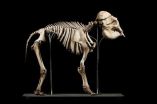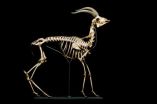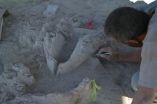(Press-News.org) One of the riddles of mammal evolution explained: the strong conservation of the number of trunk vertebrae. Researchers of the Naturalis Biodiversity Center and the University of Utah show that this conservation is probably due to the essential role of speed and agility in survival of fast running mammals. They measured variation in vertebrae of 774 individual mammal skeletons of both fast and slow running species. The researchers found that a combination of developmental and biomechanical problems prevents evolutionary change in the number of trunk vertebrae in fast running and agile mammals. In contrast, these problems barely affect slow and sturdy mammals. The study will appear next Monday, 14 July 2014 in PNAS.
The mammal vertebral column is highly variable among species, reflecting adaptations to a wide range of lifestyles, from burrowing in moles to flying in bats. Yet, as a rule, the number of trunk vertebrae varies little between most mammal species. The vertebral column and its high evolutionary potential is considered to be of central importance for the evolution of vertebrates, which is why the constancy is both puzzling and important. The authors propose, on biomechanical and developmental grounds that evolutionary change is virtually impossible in fast running and agile mammals, but only marginally affects slow and sturdy mammals. The rationale is that several mutations are necessary to change the number of trunk vertebrae, with single mutations leading to irregularly shaped transitional lumbosacral vertebrae that are incompletely and asymmetrically fused to the sacrum. These irregular lumbosacral joints reduce flexibility, thus severely hampering running and jumping. Their observations indeed show that selection against these initial changes is strong in fast and agile mammals and weak in slower and sturdier ones.
In total, 774 skeletons of 90 different species were analysed. The skeletons belonged to collections of 9 European natural history museums including Naturalis Biodiversity Center, Leiden.
"The stiffness of the back of a mammal is key to whether evolutionary change is possible or not", said Frietson Galis, one of the authors of the study. "`the locomotion of slow mammals with a stiff back is only marginally affected by irregular lumbosacral joints, but for fast running mammals such joints are fatal " continued Clara ten Broek another author of the study.
"A combination of developmental, biomechanical and evolutionary insights and a large dataset were necessary to solve this puzzle of mammal evolution", said Frietson Galis.
"The stiffness of the back of a mammal is key to whether evolutionary change is possible or not", said Frietson Galis, researcher at Naturalis Biodiversity Center and one of the authors of the study. "the locomotion of slow mammals with a stiff back is only marginally affected by irregular lumbosacral joints, but for fast running mammals such joints are fatal" continued Clara ten Broek another author of the study.
"A combination of developmental, biomechanical and evolutionary insights and a large dataset were necessary to solve this puzzle of mammal evolution", said Frietson Galis.
INFORMATION:
Images:
Photographs 1A and 1B
Title: Skeletons of a slow and sturdy elephant (1A) and of a fast and flexible Dorcas gazelle (1B).
Caption: (1A) Skeleton of a juvenile specimen of an Asian elephant with a stiff vertebral column, due to the long thorax with many ribs, the short lumbar ribless region (behind the thorax) and the dorsal spines that are all backward pointing. (1B) Skeleton of a Thomson's gazella with a flexible vertebral column, due to the short thorax, long lumbar region and the dorsal spines that are anteriorly backward pointing and posteriorly forward pointing, allowing dorsal flexion of the spine. Photo: Joris van Alphen / jorisvanalphen.com.
Licence for photo use: these photographs may freely be used in print and electronic publications about this PNAS study, provided that proper attribution to the photographer is made. For more photos and any other kind of use, contact Joris van Alphen (joris@jorisvanalphen.com, or tel. +31647554525).
Photograph 2
Title: Authors Frietson Galis (left) and Clara ten Broek investigating the vertebral column of a Thomson's gazelle. Photo: Eelco Kruidenier, © Naturalis.
Licence for photo use: This photograph may freely be used in print and electronic publications about this PNAS study, provided that proper attribution to the photographer is made.
Citation to the article: Frietson Galis, David R. Carrier, Joris van Alphen, Steven D. van der Mije, Tom J.M. Van Dooren, Johan A. J. Metz, Clara M.A. ten Broek 2014. Fast running restricts evolutionary change of the vertebral column in mammals. Proc. Natl. Acad. Sci. USA, http://www.pnas.org/cgi/doi/10.1073/pnas.1401392111
Media contacts:
For the authors: Frietson Galis, frietson.galis@naturalis.nl, Phone: +316 48814360
For Naturalis: Rebecca Reurslag, Rebecca.reurslag@naturalis.nl, Phone: +3171 56 87 625
For PNAS: PNAS News Office at pnasnews@nas.edu, Phone: +1 202-334-1310
Abstract of the article:
The mammalian vertebral column is highly variable, reflecting adaptations to a wide range of lifestyles, from burrowing in moles to flying in bats. Yet, in many taxa the number of trunk vertebrae is surprisingly constant. We argue that the latter constancy results from strong selection against initial changes of these numbers in fast-running or agile mammals, while such selection is weak in slower-running, sturdier mammals. The rationale is that changes of the number of trunk vertebrae require homeotic transformations from trunk into sacral vertebrae, or vice versa, and mutations towards such transformations generally produce transitional lumbosacral vertebrae that are incompletely fused to the sacrum. We hypothesize that such incomplete homeotic transformations impair flexibility of the lumbosacral joint and, thereby threaten survival in species that depend on axial mobility for speed and agility. Such transformations will only marginally affect performance in slow sturdy species, so that sufficient individuals with transitional vertebrae survive to allow eventual evolutionary changes of trunk vertebral numbers. We present data on fast and slow carnivores and artiodactyls and on slow afrotherians and monotremes that strongly support this hypothesis. The conclusion is that the selective constraints on the number of trunk vertebrae stem from a combination of developmental and biomechanical constraints.
Running for life: How speed restricts evolutionary change of the vertebral column
2014-07-14
ELSE PRESS RELEASES FROM THIS DATE:
Meet the gomphothere: UA archaeologist involved in discovery of bones of elephant ancestor
2014-07-14
An animal once believed to have disappeared from North America before humans ever arrived there might actually have roamed the continent longer than previously thought – and it was likely on the list of prey for some of continent's earliest humans, researchers from the University of Arizona and elsewhere have found.
Archaeologists have discovered artifacts of the prehistoric Clovis culture mingled with the bones of two gomphotheres – an ancient ancestor of the elephant – at an archaeological site in northwestern Mexico.
The discovery suggests that the Clovis – the ...
Acute glaucoma discovered to be an inflammatory disease
2014-07-14
Researchers at the University of California, San Diego School of Medicine and Sun Yat-sen University in China have shown that acute glaucoma in mice is largely an inflammatory disease and that high pressure in the eye causes vision loss by setting in motion an inflammatory response similar to that evoked by bacterial infections.
The study, published in this week's issue of the Proceedings of the National Academy of Sciences, has immediate clinical relevance in treating the tens of millions of people worldwide from what is known as acute closed-angle glaucoma.
"Our research ...
CRISPR system can promote antibiotic resistance
2014-07-14
CRISPR, a system of genes that bacteria use to fend off viruses, is involved in promoting antibiotic resistance in Francisella novicida, a close relative of the bacterium that causes tularemia. The finding contrasts with previous observations in other bacteria that the CRISPR system hinders the spread of antibiotic resistance genes.
The results are scheduled for publication in PNAS Early Edition.
The CRISPR system has attracted considerable attention for its potential uses in genetic engineering and biotechnology, but its roles in bacterial gene regulation are still ...
Older adults nearly twice as likely to have memories affected by distractions
2014-07-14
Older people are nearly twice as likely as their younger counterparts to have their memory and cognitive processes impaired by environmental distractions (such as irrelevant speech or written words presented along with target stimuli), according to a new study from psychologists at Rice University and Johns Hopkins University School of Medicine. Whereas other studies had found that older adults are distracted by memories of prior similar events, this was the first study to convincingly demonstrate across several tasks an impairment from environmental distractions.
"Cognitive ...
EARTH Magazine: Parasites spread across the Arctic under the 'new normal'
2014-07-14
Alexandria, Va. — The last several decades have seen Arctic sea-ice minimums drop by more than half in area and more than three-quarters in volume. With current models predicting further reductions, scientists are calling it the "new normal" and are trying to grasp its implications — one of which is the occurrence of pathogens never before seen in the Arctic.
Ice is a major eco-barrier for pathogens, but with Arctic ice diminishing rapidly amid the changing climate, pathogens have an opportunity to move into new areas and spread disease as mammals increase their ranges ...
Capturing cancer: A powerful new technique for early diagnosis
2014-07-14
Despite impressive medical strides, cancer remains a leading killer and overwhelming burden to healthcare systems, causing well over a half million fatalities per year with a projected cost of $174 billion by 2020, according to the National Cancer Institute. Reducing the human and economic toll will require diagnosis and intervention at early stages of illness, when the best prognosis for a cure exists.
In recent years, aggressive research and substantial financial investments have been directed at discovering pre-symptomatic indicators of cancer, known as biomarkers. ...
Labs characterize carbon for batteries
2014-07-14
Lithium-ion batteries could benefit from a theoretical model created at Rice University and Lawrence Livermore National Laboratory that predicts how carbon components will perform.
The model is based on intrinsic characteristics of materials used as battery electrodes. These include limitations on quantum capacitance (the ability of the material to absorb charge) and the material's absolute Fermi level, which determines how many lithium ions may bond to the electrodes.
Subtle changes in the structure, chemistry and shape of an electrode will alter how strongly lithium ...
Study: Young women with sexy social media photos seen as less competent
2014-07-14
BEND, Ore. – Girls and young women who post sexy or revealing photos on social media sites such as Facebook are viewed by their female peers as less physically and socially attractive and less competent to perform tasks, a new study from Oregon State University indicates.
"This is a clear indictment of sexy social media photos," said researcher Elizabeth Daniels, an assistant professor of psychology who studies the effect of media on girls' body image. Daniels' findings are based on an experiment she conducted using a fictitious Facebook profile.
"There is so much ...
Penn researchers successfully alleviate pulmonary inflammation with targeted drug delivery
2014-07-14
(PHILADELPHIA) – Pulmonary inflammation can cause shallow breathing and the lungs to become brittle in patients who experience multiple blood transfusions, sepsis, lung surgery and acute lung trauma. This complication can leave patients on ventilators, which can further traumatize the lungs, and often results in a mortality rate of 30 to 40 percent. To date, no medication has been successful at preventing or mitigating the damage caused by lung inflammation. Now, a multidisciplinary research team led by David Eckmann, MD, PhD, Horatio C. Wood Professor of Anesthesiology ...
Babies born in Canada to immigrant mothers have lower risk of cerebral palsy: Study
2014-07-14
TORONTO, July 14, 2014—Babies born to mothers who immigrated to Ontario from other countries have significantly lower rates of cerebral palsy than those of Canadian-born mothers, especially those from the Caribbean and East Asia, new research has found.
"Predicting who is at highest risk of having a child with CP remains an international priority," said lead author Dr. Joel Ray, who notes that CP rates have not declined much over the last decade.
CP is the most common motor disability in childhood and appears by the age of four. The underlying injury to the brain with ...






